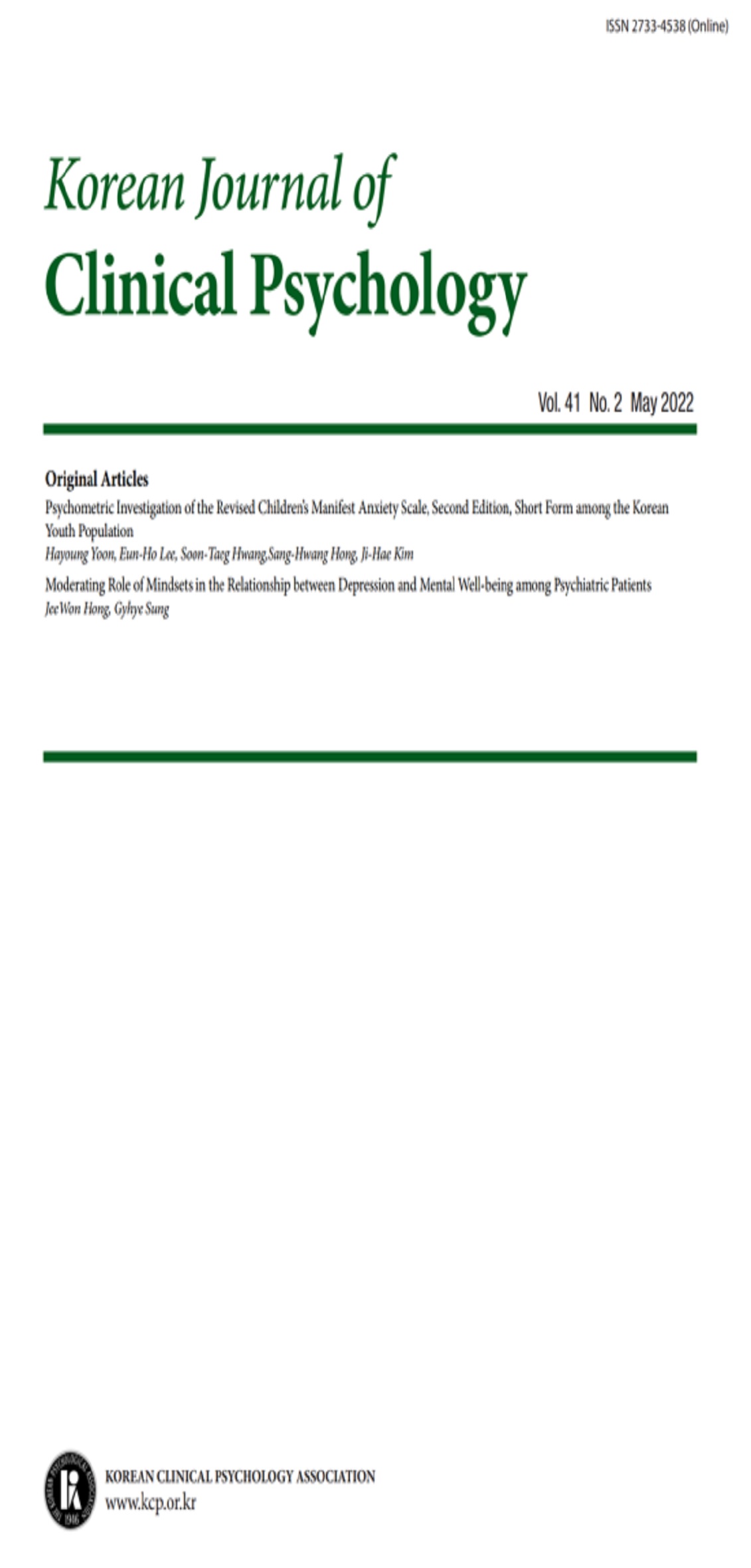open access
메뉴
open access
메뉴 E-ISSN : 2733-4538
E-ISSN : 2733-4538
포함된 문항 내용을 살펴보면, 요인 1은 공적인 모임이나 회의에서 발표를 하거나 의견을 제시하는 상황으로 “발표상황(speak)”이라고 명명할 수 있겠다. 여기에는 여러 사람들의 이목이 동시에 집중되는 상황에 대한 불안이 포함된다. 요인 2는 사람이 많은 곳에서 차를 마시고 식사를 하거나, 사람들이 모여있는 곳에 함께 있거나 혹은 모임을 갖는 상황으로, “공공장소의 상황(public)”으로 명명하였다. 이것은 일대일 상호작용이나 구체적인 상호작용을 포함하지는 않지만, 불특정 다수의 사람들이 있는 상황에 참여하는 것에 대한 두려움이나 불안 정도를 나타낸다. 한편, 요인 3은 처음 만나거나 잘 알지 못하는 사람과 대화를 하거나 전화를 하고, 만나는 상황으로서 “낯선 사람과 상호작용(strange)”이라 칭하였다. 이것은 일대일로 타인과 관계를 갖는 상황으로, 요인 2에 비하면 좀 더 적극적인 상호작용이 요구되는 상황을 포함하고 있다. 요인 4는 “자기주장 상황(assert)”으로, “물건교환하기, 문 항요인 부하량123456. 다른 사람들이 지켜보는 앞에서 어떤 행동을 하거나 연설하는 것.79.12.14.05.1916. 회의나 모임에서 말을 하는 것.77.20.22.16.0920. 여러 사람 앞에서 발표하는 것 .74.11.17.26.0215. 다른 사람들의 주의집중을 받는 것.65.27.28.14.125. 권위있는 사람과 이야기 하는 것.46.28.22.13.2318. 친하지 않은 사람에게 반대의견을 표현하는 것.37.20.30.32.1414. 다른 사람들이 앉아있는 방에 들어가는 것.36.33.34.18.163. 사람들이 많은 곳에서 식사하는 것.14.75.13.21.104. 사람들이 많은 곳에서 다른 사람들과 차 마시는 것.13.74.12.18.122. 몇몇 사람들이 모여있는 곳에 함께 있는 것.29.64.27.08.137. 모임 혹은 파티에 참석하는 것.39.48.26.17.2023. 모임을 여는 것.30.36.23.34.2111. 내가 잘 알지 못하는 사람과 대화하는 것.27.23.77.17.1312. 낯선 사람을 만나는 것.27.27.77.18.0710. 내가 잘 알지 못하는 사람에게 전화하는 것.21.04.59.26.2919. 내가 잘 알지 못하는 사람들을 바라보는 것.20.27.41.32.1022. 상점에서 물건을 교환하거나 환불하는 것.20.17.24.62.2324. 판매원의 강매를 거절하는 것.15.21.17.60.099. 다른 사람이 보는 앞에서 글씨를 쓰는 것.14.20.18.26.518. 남들이 지켜보는 앞에서 일하는 것.43.28.24.14.51고유값3.52.62.51.61.0설명변량(%)17.7213.0712.577.824.92누적설명변량(%)17.7230.7943.3751.1956.11Cronbach's alpha.87.84.83.73.64거절하기” 등 일대일 대면 상황에서 자신의 생각을 적극적으로 주장해야하는 상황에 대한 두려움이다. 마지막으로 요인 5는 다른 사람 앞에서 글씨를 쓰거나 일을 하는 등의 수행상황으로 “다른 사람이 지켜보는 앞에서의 수행상황(obs)”으로 명명하였다. 이 결과는 표 2에 제시하였다.
This study attempted to examine the factor structure of a Korean version of the Liebowitz Social Anxiety Scale (K-LSAS) and its diagnostic efficiency. Subjects consisted of 755 college students and 32 social phobic patients and exploratory factor analysis was used to identify situational factors provoking intensive fear in social phobia. As a result, the following 5 factors were extracted: (1) speaking, (2) doing something while being observed, (3) public situation, (4) interaction with stranger, and (5) assertive situation. The reliability and validity of K-LSAS is also highly significant among these subjects. Finally we examined the difference of score on K-LSAS and its subscales between two groups, and discussed the value of K-LSAS on accurate diagnosis for social phobia. The application to specific cutoff scores of each subscale and total score on the K-LSAS would greatly enhance the diagnostic utility for social phobia. Therefore, K-LSAS can be beneficial for clinicians to evaluate social phobic individuals accurately in order to make efficient treatment plans.
(2001) 사회공포증의 하위유형이 인지행동집단치료 효과에 미치는 영향. ,
(2001) 사회공포증의 인지행동집단치료 효과에 대한 연구,
(2003) 사회불안 유발상황의 구분 및 사회불안 하위유형의 차별적 특성. ,
(1991) MMPI-D 척도의 신뢰도 및 타당도에 대한 연구. 한국심리학회지,
(1997) 한국판 사회공포증 척도(K-SAD, K-FNE)의 신뢰도 및 타당도 연구,
(2004) 한국판 발표불안 사고 검사의 신뢰도와 타당도,
(1994) . 사회적 불안에서의 비합리적 신념과 상황요인. 한국심리학회지 상담과 심리치료,
(2002) The Liebowitz social anxiety scale as a self-report instrument: a preliminary psychometric analysis,
(1998) A Comparison of social phobia outcome measures in cognitive-behavioral group therapy.,
(1995) Factor analysis in the development and refinement of clinical assessment instruments,
(1995) The clinical interview. In R. G. Heimberg, M. R. Liebowitz, D. A. Hope, & F. R. Schneier(Eds.), Social Phobia: Diagnosis, assessment and treatmnet, New York: Guilford Press
(1985) . Treatment of social phobia by exposure and homework assignments. Journal of Nervous and Mental Disease. 173,
(1999) Psychometric properties of the Liebowitz Social Anxiety Scale,
(1999) Factor structure of social fears: The Liebowitz Social Anxiety Scale.,
(1992) . Validity of the distinction between generalized social phobia and avoidant personality disorder. Journal of Abnormal Psychology,
(1992) . Situational domains of social phobia. Journal of Anxiety Disorders,
(1998) Social phobia subtypes in the National Comorbidity Survey,
(2002) Psychometric properties and three proposed subscales of a self-report version of the Liebowitz social anxiety scale translated into Hebrew,
(1987) . Social phobia. Modern Problems of Pharmacopsychiatry,
(2002) Screening for social anxiety disorder in the clinical setting: using the Liebowitz Social Anxiety Scale,
(2001) Putative clinical subtypes of social phobia: a factor-analytical study.,
(1999) Factor structure of social fears: The Liebowitz Social Anxiety Scale,
(2003) In search of social phobia subtypes: similarity of feared social situations.,
(2000) Social phobia symptoms, subtypes, and severity,
(1988) . Some further comments on the measurement of social phobia. Behaviour Research and Therapy,
(1986) . Situational determinants of social anxiety in clinic and nonclinic sample Physiological and cognitive correlation. Journal of Consulting and Clinical Psychology,
(1992) a comparison of specific and generalized subtypes and avoidant personality disorder. Journal of Abnormal Psychology,
(1969) . Measurement of social-evaluative anxiety. Journal of Consulting and Clinical Psychology,
